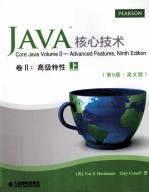

JAVA核心技术 卷2 高级特性 上 第9版英文版PDF电子书下载
- 电子书积分:16 积分如何计算积分?
- 作 者:(美)CAY S.HORSTMANN,GARY CORNELL著
- 出 版 社:北京:人民邮电出版社
- 出版年份:2013
- ISBN:9787115319487
- 页数:548 页
Chapter 1:Streams and Files 1
1.1 Streams 2
1.1.1 Reading and Writing Bytes 2
1.1.2 The Complete Stream Zoo 4
1.1.3 Combining Stream Filters 9
1.2 Text Input and Output 13
1.2.1 How to Write Text Output 13
1.2.2 How to Read Text Input 16
1.2.3 Saving Objects in Text Format 16
1.2.4 Character Sets 20
1.3 Reading and Writing Binary Data 25
1.3.1 Random-Access Files 28
1.4 ZIP Archives 33
1.5 Object Streams and Serialization 36
1.5.1 Understanding the Object Serialization File Format 42
1.5.2 Modifying the Default Serialization Mechanism 48
1.5.3 Serializing Singletons and Typesafe Enumerations 50
1.5.4 Versioning 52
1.5.5 Using Serialization for Cloning 54
1.6 Working with Files 57
1.6.1 Paths 57
1.6.2 Reading and Writing Files 60
1.6.3 Copying,Moving,and Deleting Files 61
1.6.4 Creating Files and Directories 62
1.6.5 Getting File Information 63
1.6.6 Iterating over the Files in a Directory 64
1.6.7 ZIP File Systems 67
1.7 Memory-Mapped Files 68
1.7.1 The Buffer Data Structure 77
1.7.2 File Locking 79
1.8 Regular Expressions 81
Chapter 2:XML 93
2.1 Introducing XML 94
2.1.1 The Structure of an XML Document 96
2.2 Parsing an XML Document 99
2.3 Validating XML Documents 113
2.3.1 Document Type Definitions 114
2.3.2 XML Schema 122
2.3.3 A Practical Example 125
2.4 Locating Inforrnation with XPath 140
2.5 Using Namespaces 147
2.6 Streaming Parsers 150
2.6.1 Using the SAX Parser 150
2.6.2 Using the StAX Parser 156
2.7 Generating XML Documents 159
2.7.1 Documents without Namespaces 159
2.7.2 Documents with Namespaces 160
2.7.3 Writing Documents 161
2.7.4 An Example:Generating an SVG File 161
2.7.5 Writing an XML Document with StAX 164
2.8 XSL Transformations 173
Chapter 3:Networking 185
3.1 Connecting to a Server 185
3.1.1 Socket Timeouts 190
3.1.2 Internet Addresses 192
3.2 Implementing Servers 194
3.2.1 Serving Multiple Clients 197
3.2.2 Half-Close 201
3.3 Interruptible Sockets 202
3.4 Getting Web Data 210
3.4.1 URLs and URIs 210
3.4.2 Using a URLConnection to Retrieve Information 212
3.4.3 Posting Form Data 222
3.5 Sending E-Mail 230
Chapter 4:Database Programming 235
4.1 The Design of JDBC 236
4.1.1 JDBC Driver Types 236
4.1.2 Typical Uses of JDBC 238
4.2 The Structured Query Language 239
4.3 JDBC Configuration 245
4.3.1 Database URLs 246
4.3.2 Driver JAR Files 246
4.3.3 Starting the Database 247
4.3.4 Registering the Driver Class 248
4.3.5 Connecting to the Database 249
4.4 Executing SQL Statements 252
4.4.1 Managing Connections,Statements,and Result Sets 255
4.4.2 Analyzing SQL Exceptions 256
4.4.3 Populating a Database 258
4.5 Query Execution 262
4.5.1 Prepared Statements 263
4.5.2 Reading and Writing LOBs 269
4.5.3 SQL Escapes 271
4.5.4 Multiple Results 272
4.5.5 Retrieving Autogenerated Keys 273
4.6 Scrollable and Updatable Result Sets 274
4.6.1 Scrollable Result Sets 274
4.6.2 Updatable Result Sets 277
4.7 Row Sets 281
4.7.1 Constructing Row Sets 282
4.7.2 Cached Row Sets 282
4.8 Metadata 286
4.9 Transactions 296
4.9.1 Save Points 297
4.9.2 Batch Updates 298
4.9.3 Advanced SQL Types 300
4.10 Connection Management in Web and Enterprise Applications 302
Chapter 5:Internationalization 305
5.1 Locales 306
5.2 Number Formats 311
5.2.1 Currencies 318
5.3 Date and Time 319
5.4 Collation 328
5.4.1 Collation Strength 329
5.4.2 Decomposition 329
5.5 Message Formatting 336
5.5.1 Choice Formats 338
5.6 Text Files and Character Sets 340
5.6.1 Character Encoding of Source Files 340
5.7 Resource Bundles 341
5.7.1 Locating Resource Bundles 342
5.7.2 Property Files 343
5.7.3 Bundle Classes 344
5.8 A Complete Example 346
Chapter 6:Advanced Swing 363
6.1 Lists 364
6.1.1 The JList Component 364
6.1.2 List Models 370
6.1.3 Inserting and Removing Values 375
6.1.4 Rendering Values 377
6.2 Tables 381
6.2.1 A Simple Table 382
6.2.2 Table Models 386
6.2.3 Working with Rows and Columns 390
6.2.3.1 Column Classes 390
6.2.3.2 Accessing Table Columns 392
6.2.3.3 Resizing Columns 392
6.2.3.4 Resizing Rows 393
6.2.3.5 Selecting Rows,Columns,and Cells 394
6.2.3.6 Sorting Rows 395
6.2.3.7 Filtering Rows 396
6.2.3.8 Hiding and Displaying Columns 398
6.2.4 Cell Rendering and Editing 408
6.2.4.1 Rendering the Header 409
6.2.4.2 Cell Editing 410
6.2.4.3 Custom Editors 411
6.3 Trees 420
6.3.1 Simple Trees 421
6.3.1.1 Editing Trees and Tree Paths 431
6.3.2 Node Enumeration 440
6.3.3 Rendering Nodes 442
6.3.4 Listening to Tree Events 445
6.3.5 Custom Tree Models 453
6.4 Text Components 462
6.4.1 Change Tracking in Text Components 463
6.4.2 Formatted Input Fields 467
6.4.2.1 Integer Input 468
6.4.2.2 Behavior on Loss of Focus 468
6.4.2.3 Filters 470
6.4.2.4 Verifiers 471
6.4.2.5 Other Standard Formatters 472
6.4.2.6 Custom Formatters 474
6.4.3 The JSpinner Component 485
6.4.4 Displaying HTML with the JEditorPane 494
6.5 Progress Indicators 501
6.5.1 Progress Bars 501
6.5.2 Progress Monitors 505
6.5.3 Monitoring the Progress of Input Streams 509
6.6 Component Organizers and Decorators 514
6.6.1 Split Panes 514
6.6.2 Tabbed Panes 518
6.6.3 Desktop Panes and Internal Frames 524
6.6.4 Cascading and Tiling 527
6.6.5 Vetoing Property Settings 531
6.6.5.1 Dialogs in Internal Frames 533
6.6.5.2 Outline Dragging 534
6.6.6.3 Layers 543
- 《钒产业技术及应用》高峰,彭清静,华骏主编 2019
- 《现代水泥技术发展与应用论文集》天津水泥工业设计研究院有限公司编 2019
- 《异质性条件下技术创新最优市场结构研究 以中国高技术产业为例》千慧雄 2019
- 《Prometheus技术秘笈》百里燊 2019
- 《中央财政支持提升专业服务产业发展能力项目水利工程专业课程建设成果 设施农业工程技术》赵英编 2018
- 《指向核心素养 北京十一学校名师教学设计 英语 七年级 上 配人教版》周志英总主编 2019
- 《药剂学实验操作技术》刘芳,高森主编 2019
- 《林下养蜂技术》罗文华,黄勇,刘佳霖主编 2017
- 《脱硝运行技术1000问》朱国宇编 2019
- 《催化剂制备过程技术》韩勇责任编辑;(中国)张继光 2019
- 《SQL与关系数据库理论》(美)戴特(C.J.Date) 2019
- 《魔法销售台词》(美)埃尔默·惠勒著 2019
- 《看漫画学钢琴 技巧 3》高宁译;(日)川崎美雪 2019
- 《优势谈判 15周年经典版》(美)罗杰·道森 2018
- 《社会学与人类生活 社会问题解析 第11版》(美)James M. Henslin(詹姆斯·M. 汉斯林) 2019
- 《海明威书信集:1917-1961 下》(美)海明威(Ernest Hemingway)著;潘小松译 2019
- 《迁徙 默温自选诗集 上》(美)W.S.默温著;伽禾译 2020
- 《上帝的孤独者 下 托马斯·沃尔夫短篇小说集》(美)托马斯·沃尔夫著;刘积源译 2017
- 《巴黎永远没个完》(美)海明威著 2017
- 《剑桥国际英语写作教程 段落写作》(美)吉尔·辛格尔顿(Jill Shingleton)编著 2019
- 《指向核心素养 北京十一学校名师教学设计 英语 七年级 上 配人教版》周志英总主编 2019
- 《办好人民满意的教育 全国教育满意度调查报告》(中国)中国教育科学研究院 2019
- 《北京生态环境保护》《北京环境保护丛书》编委会编著 2018
- 《人民院士》吴娜著 2019
- 《指向核心素养 北京十一学校名师教学设计 英语 九年级 上 配人教版》周志英总主编 2019
- 《中国人民的心》杨朔著;夕琳编 2019
- 《高等院校旅游专业系列教材 旅游企业岗位培训系列教材 新编北京导游英语》杨昆,鄢莉,谭明华 2019
- 《中华人民共和国成立70周年优秀文学作品精选 短篇小说卷 上 全2册》贺邵俊主编 2019
- 《指向核心素养 北京十一学校名师教学设计 数学 九年级 上 配人教版》周志英总主编 2019
- 《中华人民共和国成立70周年优秀文学作品精选 中篇小说卷 下 全3册》洪治纲主编 2019
